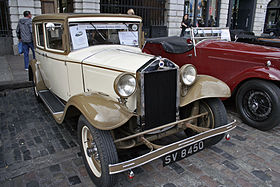Lancia Artena
| Lancia Artena | |
|---|---|

1930 Lancia Artena Berlina
|
|
| Overview | |
| Manufacturer | Lancia |
| Production | 1931–1936 1940–1942 |
| Body and chassis | |
| Body style | |
| Layout | Front-engine, rear-wheel-drive |
| Related | Lancia Astura |
| Powertrain | |
| Engine | 1,924 cc Lancia tipo 84 V4 (petrol) |
| Transmission | 4-speed manual |
| Dimensions | |
| Wheelbase |
|
| Length |
|
| Width |
|
| Kerb weight | 1,350 kg (2,976 lb) |
| Chronology | |
| Predecessor | Lancia Lambda |
The Lancia Artena (Tipo 228) is a passenger car produced by Italian car manufacturer Lancia from 1931 to 1936, and from 1940 to 1942 chiefly for army and government use. It was powered by a 2-litre Lancia V4 engine, while chassis and factory bodies were shared with the more luxurious 2.6-litre V8-engined Lancia Astura. Total production amounted to 5,567 examples.
Artena and her sister Astura made their début at the October 1931 Paris Motor Show. Interrupting Lancia's decade-old tradition of naming its cars with Greek letters, the new model was named after Artena, an ancient town of the pre-Roman Volsci people.
The Lancia Astura was a more powerful and more luxurious version of this car based on the same platform. Besides the engines, main differences between the two cars were the Artena's Michelin disc wheels instead of the Astura's Rudge-Whitworth wire wheels, and the Astura's longer wheelbase.
There were four successive versions of the car. The first series was built between autumn of 1931 through summer of 1932; during the next year the second series was produced, and the third series from Autumn 1933 till the start of 1936.
Deliveries began in December 1931. The 2-litre engine put out 55 hp (41 kW). For 1932 the Artena was available from the factory in two 4-door body styles—four-window saloon seating four and six-window saloon seating six—or as bare chassis.
Second series changes were light; the car now incorporated modified engine mountings to reduce noise and vibrations.
The third series brought deeper changes, including new bodywork with a slanted grille. The chassis was modified and made available in two different wheelbase lengths, short (3.0 m, chassis tipo 228C) and normal (3.2 m, chassis tipo 228A)—hitherto a prerogative of the more expensive Astura. The new 1934 range introduced in late 1933 thus included short or normal bare chassis, four passenger saloon on the short chassis, and six passenger saloon on the normal chassis. In total 1,552 Artena 228As and 488 short-wheelbase Artena 228Cs were made.
...
Wikipedia
